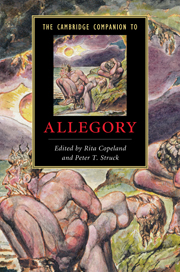Book contents
- Frontmatter
- Introduction
- Part I: Ancient foundations
- Part II: Philosophy, theology, and poetry 200 to 1200
- Part III: Literary allegory: philosophy and figuration
- 8 Allegory in the Roman de la Rose
- 9 Dante and allegory
- 10 Medieval secular allegory: French and English
- 11 Medieval religious allegory: French and English
- 12 Renaissance allegory from Petrarch to Spenser
- 13 Protestant allegory
- 14 Allegorical drama
- Part IV: The fall and rise of allegory
- Further reading
- Index
14 - Allegorical drama
from Part III: - Literary allegory: philosophy and figuration
Published online by Cambridge University Press: 28 January 2011
- Frontmatter
- Introduction
- Part I: Ancient foundations
- Part II: Philosophy, theology, and poetry 200 to 1200
- Part III: Literary allegory: philosophy and figuration
- 8 Allegory in the Roman de la Rose
- 9 Dante and allegory
- 10 Medieval secular allegory: French and English
- 11 Medieval religious allegory: French and English
- 12 Renaissance allegory from Petrarch to Spenser
- 13 Protestant allegory
- 14 Allegorical drama
- Part IV: The fall and rise of allegory
- Further reading
- Index
Summary
Prudentius' Psychomachia, Guillaume de Lorris and Jean de Meun's Roman de la Rose, Dante's Divina Commedia, and Petrarch's Trionfi invest combats, triumphs, dances, and other festive and dramatic forms with allegorical significance. But the costumes they describe, the personifications they introduce, and the mystical visions in which they culminate appear only in the mind's eye. In allegorical dramas, on the other hand, actors change their costumes in order to make the states of their characters' souls visible; they perform stage business like hiding a board beneath the earth to discourage Mankind's labors; and they descend from the heavens in machines. The symbolic loci that so often stand out from narrative allegories and ask to be mapped in the imagination are actually arranged in the space of the playing area, which may oppose the mansion of the World to the Heavenly Paradise or may use platforms and scaffolds to create different planes of action proper to demons, mortals, and heavenly spirits. In some cases, allegorical plays turn the conditions of their own performance into an extended metaphor. In El Gran Teatro del Mundo (The Great Theatre of the World) (c. 1640-45), for example, Calderón de la Barca presents life as a play in which Men are the actors, the World is in charge of the properties and the stage, and the producer is God: the actors are assigned parts, but they must perform them without a script and without rehearsal.
- Type
- Chapter
- Information
- The Cambridge Companion to Allegory , pp. 191 - 208Publisher: Cambridge University PressPrint publication year: 2010



